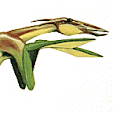Once upon a time there was so little material about speculative biology that I used to search the internet for speculative biology works. I was looking for works with a fair number of creations, a biology that made sense, and artwork that was a pleasure to look at. Sometimes I found nothing of interest, and at other times I found one or two projects. When I liked the project enough, I contacted the author which usually resulted in a blog post.
As time passed, speculative biology more or less exploded, and my searches began to reveal so many projects that I did not know which ones to pick. Later I gave up, or otherwise I would never get to work on Furaha.
But now, someone had the nice idea to produce a magazine about speculative biology. You will not find printed copies on your local newsstand, but it exists all the same, as an online pdf magazine. I am talking about 'Astrovitae'. The four issues that have been produced so far look very professional, and it wouldn’t hurt to see them in print. You can find those issues here, on the magazine's website. As mentioned on the website, the magazine aims to connect speculative biology artists around the globe. It is produced by the founder and chief editor of the magazine, Domenic Pennetta, whom I asked a few questions.
 |
| Click to enlarge; from #1; Copyright John Meszaros |
Because the magazine looked so good, I began by asking Domenic why it was free; I thought it was because you can download the issues without any bother from the site. Domenic was quick to correct me that hosting the site does cost money, and there is also his own time to consider. Right now, there are enough readers and contributors who care enough to help fund web hosting. Domenic points out that he wasn't initially sure how well the magazine would be received, and that played a role in deciding to ask for voluntary contributions only.
 |
| Click to enlarge; from #2. copyright Lorenzo Battilani |
My next question was also inspired by the professional look of the magazine: is Domenic a graphic designer by profession? He did not consider himself to be one at the time, but the project helped him hone his designing skills, and he eventually got a job as an assistant designer because Astrovitae looked so good! Domenic added that he hopes to help other artists by publishing their work in Astrovitae.
I wondered whether publishing Astrovitae was just a hobby or the start of something bigger? Domenic wrote:
"I think this is a great question! It may help to briefly explain the origin of the magazine to fully answer this. When I first became involved in the genre and started my own speculative biology project, I quickly met other artists online who were interested in the same topics. We began forming small gatherings over social media, like Instagram groups or discord servers. All of us would periodically meet to discuss the genre, critique each other's art, and explain or explore scientific concepts with each other. I saw a lot of interaction going on, but despite so many like-minded artists in one space, no one was really collaborating to our fullest extent when it came to art. So, I had an idea to start some sort of publication, likely something small, that would feature work from all amateur artists interested in the genre. I felt that by doing this, I could inspire my fellow artists to work together more closely."
 |
| Click to enlarge; from #3. copyright ND Cebula |
For Domenic, Astrovitae is a way to bridge a gap between different social media, hoping that artists from every corner of the internet could become familiar with each other’s work. He adds:
"I also have a background in scientific illustration. I love the natural world and learning about the biology of living organisms, depicting how they work or what drives them to behave, and also taking obscure organisms and bringing them alive through art. To me, even though speculative biology is heavily analytical and aligned with science, it is also associated with art. I think most scientific illustrators feel the same as me and believe art and science are indistinguishable from one another—they go hand in hand. Art is a form of communication that is useful in explaining complex ideas, like the concepts found in biology and other sciences. Starting a magazine would allow me to further influence the genre into an art-affiliated direction. This would allow the community to further explore and convey the speculative animals and biology we imagine.
So, in conclusion, I do believe that Astrovitae is something bigger. It is a tool to connect creative minds, facilitate collaboration, get artists published and seen, and better communicate speculative concepts we explore within the genre."
 |
| Click to enlarge; from #4. Copyright Paul Drenckhahn |
Well said! As someone with a very similar interest in science and art I can only agree, and I hope that Astrovitae magazine will grow to become what Domenic envisioned.
You can read Astrovitae magazine online here. Additionally , if you are interested in participating in the magazine, feel free to contact Domenic at astrovitae@gmail.com or see www.astrovitae.com/submissions for details.
I hope I whetted readers' appetites enough to go and have a look at the four issues available at present. To help you decide (and make this post more exciting) I used a double page spread from each of the four issues to illustrate this post. I will not discuss the creations on these pages at any length; that's what the magazine is for!





















